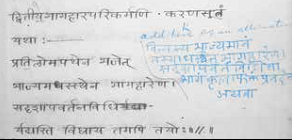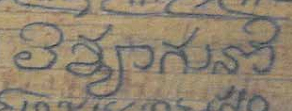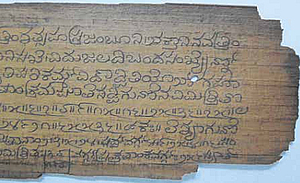
Centre of Jaina Studies Newsletter: SOAS - University of London
The Gaṇitasārasaṃgraha (GSS) is a very significant Sanskrit treatise on mathematics, maybe the first one to have survived in a complete form. It was composed by Mahāvīrācārya, a Jaina Digambara ācārya living in the 9th century during the reign of Amoghavarṣa, a Rāṣṭrakūṭa king ruling in Maharashtra and Karnataka. The discovery, edition and translation into English of this text were done by M. Rangacharya who had chanced upon a few of its manuscripts in the Government Oriental Manuscripts Library (GOML) at Madras. His publication (1912) has been a landmark in the historiography of Indian mathematics as it has introduced to the international community of scholars this voluminous text containing more than a thousand verses.
During the one hundred and odd years since 1912, much has been written on the GSS's mathematical contents, but no attempt has been undertaken to reexamine the text established by Rangacharya nor to trace the Jaina philosophical and cosmological elements in it, in spite of the fact that Jaina Studies has developed rapidly during the 20th century. The importance given to mathematics (gaṇita) by the Jaina thinkers who wanted to quantify in full details the entities existing in the universe is now well known, and the technical and specialized Jaina vocabulary attached to it is also better understood.
The GSS is considered to be a pāṭīgaṇita (board mathematics) work as it is spread over an introductory chapter and eight numbered mathematical subjects called "practices" or "procedures" (vyavahāra) which expound rules (sūtra) prescribing algorithms for solving problems relating to "worldly" mathematics, and examples (uddeśaka) to be solved by means of these rules. But these eight "practices" do not exactly tally in content with the ones listed by other authors and some questions then arise about the GSS's structure: For example, it is not known why the treatment of "operations" (parikarman) is the very first of the eight "practices" (vyavahāra), when, usually, parikarman and vyavahāra constitute two sections clearly separated in pāṭīgaṇita works. Even in the first "practice" itself (parikarman), it is not known why the author, Mahāvīrācārya, has dispensed with the canonical operations of addition and subtraction of whole numbers and has replaced them by the summation and subtraction of quantities in progression, or series, making then the multiplication the first of the eight arithmetical operations (multiplication, division, squares and square roots, cubes and cube roots, summation and subtraction of series).
In the GSS, the exceptionally developed and wellwritten introductory chapter supplies a great amount of details about the organization of mathematical topics and many explicit references to the Jaina context. The GSS's first two chapters are then both fundamental, and in my thesis I have proposed a deep study of them along with a French translation.
In order to re-examine Rangacharya's text and to identify his editorial choices, I examined some manuscripts available at the GOML (Madras) hoping to find traces of his work and, in order to get a wider view on the elements of mathematics linked to the Jaina universe, I explored excerpts of different original texts (Dhavalā, Trilokasāra, etc.) but mainly of the Tiloyapaṇṇaṭṭī (TP), a Prakrit text (~ 6th to 9th century) belonging to the same Digambara tradition. The study of the impressive mathematical content of these texts has led me to propose answers to the two questions about the GSS's structure mentioned above.
From the Census of D. Pingree for the GSS, the manuscripts GOML-13409 (a beautiful palm leaf manuscript written in Sanskrit in an elegant Kannara script and accompanied by a short running commentary) and GOML-13412 have proved to be very useful, as well as the "Notes of Karanja" which had been gathered by H.L. Jain in the beginning of the 20th century and published as an Annex to the printed edition of the Hindi translation of the GSS done by L.C. Jain in 1963. The manuscript GOML-13412 which is on paper and written in Nagari script seems to be the "draft" used by Rangacharya for his pre-print edition as there are marks and notes written with a blue pencil which correspond to his final publication. The GOML-13409 appears to be the manuscript noted K by M. Rangacarya on his "draft". For example, p. 22 of GOML-13412, an alternative rule for the operation of division is suggested:

For the Tiloyapaṇṇattī (TP), I used the edition made by A.N. Upadhye and H.L. Jain (reprints in 2007-2008) and the one by Āryikā Śrī Viśuddhamatī Mātājī.[1]
Usually, the introductory chapters of pāṭīgaṇita works are short and dry, giving mainly lists of topics, names of powers of ten and units of measurement, without attempting to engage in more detailed information. This is just not the case for the GSS where the narrative and poetic talents of the author and its reverence for the Jaina doctrine shine in many verses. On this point, I feel that Rangacharya's interpretations are sometimes inadequate, by lack of knowledge of the Jaina technical vocabulary: For example, his translations of sāmāyika (GSS 1.9) by "some religious affair" and of Bhavana(-vāsin) (GSS 1.13-14) by "inhabitants of the (earthly) world,"etc., are too vague.
To express numbers, Mahāvīrācārya makes an intensive use of the word-numeral (bhūta-saṃkhyā) system, choosing often words belonging to the Jaina terminology, as for example leśyā, associated to number 6.

GOML-13409 (fol. 3, v°): leśyā guṇe (GSS 2.34)
Here, Rangacharya, probably not knowing the meaning of leśyā, deliberately corrected it into lekhyā, which is incorrect.

GOML-13412, p. 27: leśyā guṇeṣu-bāṇa
There are other bhūta-saṃkhyā terms which would need to be commented upon, particularly khara, associated with number 6, and rūpa, associated with number 1. The exact links between these words and their numerical value seems to be uncertain or lost. In my thesis, I show that the "Notes of Karanja" propose a link between khara and jīva (khara iti ṣaḍ jīva), and, as far as rūpa is concerned, I propose to connect it to the value 1 from the frequently used operation in cosmology called "diffusion-distribution-multiple multiplication" (viralana-deya-vargana-saṃvargana).
Rangacharya made a number of editorial choices, and much can be said on them. For example, he inserted titles and subtitles to separate different topics and gathered the answers to the problems at the end of his publication, while they appear immediately after the text of the problem in palm leaf manuscripts. His list of names for powers of 10 stops at the 24th place, while it goes up to the 31th one in the manuscripts GOML-13410 and 13411. He also sometimes inserts parts of the commentaries in the text itself, without mentioning it, probably trying to bring clarity to the mathematical content. The most striking example is the rule for the first operation, the multiplication, where the meaning of the compound rāśyargha-khaṇḍa-tatstha cannot be deciphered without the help of the commentary: his translation reflects exactly the content of the commentaries.
His failure to consider the terms bhoga-bhūmi and karma-bhūmi as parts of units of lengths have led him to permutate the pāda 26cd and 27ab in order to get to a plausible list of units from the trasareṇu to the aṅgula (GSS 1.25-27), but an incorrect one. The śiroruha being of four kinds, the quantity of atoms (aṇu) in one fingerbreadth (aṅgula) is 8 multiplied by itself ten times instead of 8 multiplied by itself seven times. This information as well as many others can be obtained from the study of cosmological and fundamental texts.
On a larger basis, the study of these fundamental texts brings to light the exceptional and impressive refinement of the mathematical tools and concepts used by the Jaina thinkers: These are far from being elementary, especially when they deal with the quantification and comparison of different degrees of infinities, or what we might call transfinite ordinals and transfinite cardinals. I develop this topic intensively in my thesis, showing how the scaffolding of units of time leads to the rigorous definitions of saṃkhyāta (or saṃkhyeya), asaṃkhyāta (or asaṃkhyeya) and ananta, the omnipresent terms in the Jaina literature. After a long list of units of time multiple of the yuga (5 years), one reaches the acalātma which, in modern terms would contain 150 digits. But, in order to get to the highest (utkṛṣṭa) "numerable" (saṃkhyeya) quantity and the lowest "innumerable" (asaṃkhyeya) quantity, the iterative procedure changes radically and looks like an attempt to approach the idea of "actual infinity," as compared to "potential infinity." The rigorous definitions implemented there make me come to the conclusion that it would be preferable not to translate the technical terms saṃkhyāta, asaṃkhyāta and ananta, as a translation with the help of imprecise terms like "numerable, innumerable and infinite" would make that rigor disappear.

GOML-13409 (fol. 3, v°)
Palm-leaf manuscript, circa 19th century
Collection: Government Oriental Manuscripts
Library (GOML) (Madras/Chennai)
The excerpt shown above is at the end of the
third line from below.
© Government Oriental Manuscripts Library
(GOML)
Photo: Catherine Morice-Singh
To conclude, I would say that Mahāvīrācārya has, in every aspect of his work, managed to retain the essential and to separate "alaukika gaṇita" from "laukika gaṇita" without departing from the teachings of his tradition. For instance, the units of length in the GSS (GSS 1.25) start with the atom (aṇu) which is made of an ananta quantity of ultimate particles (paramāṇu), and an asaṃkhya number of samaya is required to constitute the first unit of time, the āvalī (GSS 1.32): The distinction between ananta and asaṃkhyāta is kept here, even if its utility doesn't appear in a mathematical text.
Many operations or other mathematical tools are used in cosmology, and references are sometimes made to the existence of texts or parts of texts which have been lost: For instance, the Parikarma which is supposed to contain the necessary "preparations" to understand the Dṛṣṭivāda. In order to answer the two questions I initially mentioned about the GSS's structure, I think that to translate parikarman as "preparations" instead of "operations" would be a better choice. Every author obviously chooses the "preparations" needed for the comprehension of the work he is composing: That would explain why the content and number of parikarmans is so diverse in pāṭīgaṇita works. Some of these "preparations" might require explanations and practice, which would explain why the first "practice" in the GSS deals with parikarman.
Now, series are widely used in the Jaina cosmology, for example arithmetical progressions to describe the lower world where every data is calculated with the help of algorithms often similar to the ones in the GSS, and both arithmetical and geometrical progressions for the description of the middle world. My contention is that Mahāvīrācārya could not but put the treatment of series in the list of "preparations" for the GSS, the canonical operations of addition and subtraction being way too simple and not in conformity with the level of mathematics there.
Catherine Morice-Singh, PhD University Paris-3 Sorbonne Nouvelle (France), is currently teaching mathematics, Paris (France). Her doctoral dissertaion is entitled: Mathématiques et cosmologie jaina Nombres et algorithmes dans le Gaṇitasārasaṃgraha et la Tiloyapaṇṇattī.

Purusha or Cosmic Man, from a Sangrahani Sutra MS
Gujarat, mid-16th century
Gouache and ink on paper
EA2012.395p, Simon Digby Memorial Charity Gift
Image © Ashmolean Museum,
University of Oxford
 Dr. Catherine Morice-Singh
Dr. Catherine Morice-Singh